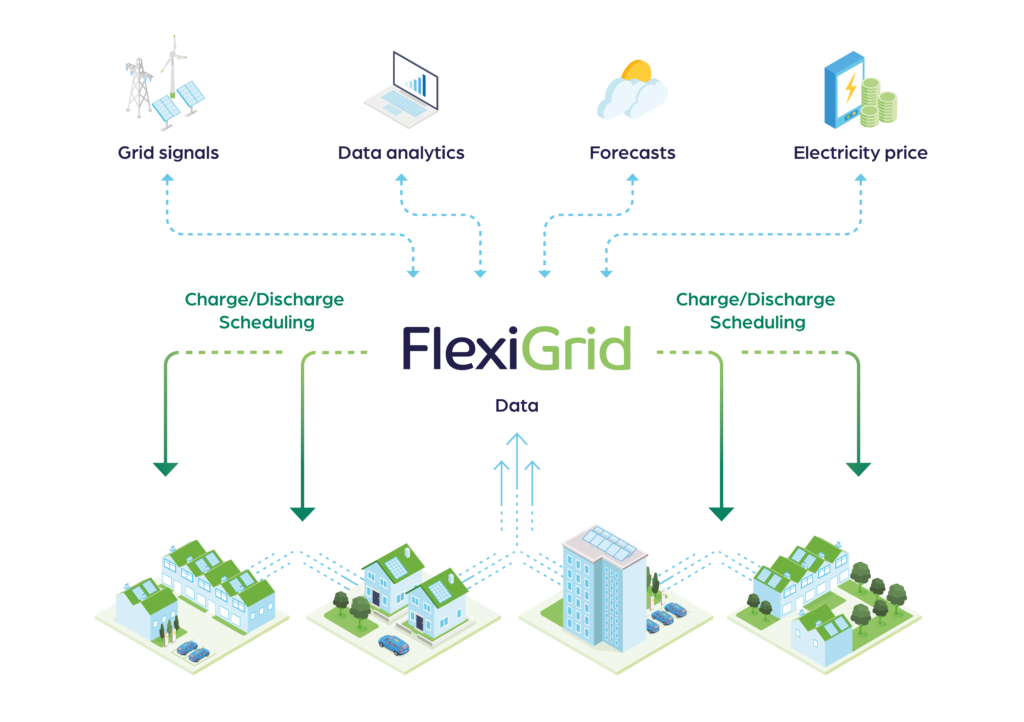Tech Talks: Q&A with Senior Data Scientist, Kilian Edwards

In the first of a new series of Tech Talks – which delves into the minds of our Software Engineers and discusses their work developing our energy tech – we talk to Senior Data Scientist, Kilian Edwards, about FlexiGrid™ and how the platform is helping intelligently address the challenges of decarbonising the energy system.
Hi Kilian. First off, can you tell us a little bit about FlexiGrid software?
FlexiGrid is our cloud-based software that communicates with, monitors, and controls a range of distributed energy resources (DERs) to create smart, flexible local energy systems. DERs are basically on-site generation and storage assets – such as solar PV, batteries, electric vehicle chargepoints, and smart heating systems that are installed in homes and businesses.
What FlexiGrid does is basically remotely control these flexible energy assets in real time as a Virtual Power Plant (VPP) in order to intelligently manage demand and enable a load of different advantages for a wide variety of stakeholders, such as home and business owners, system operators, and energy suppliers. For example, FlexiGrid balances renewable generation locally, can manage local grid constraints, and provide balancing and ancillary services to the national grid.
Ultimately, the software aims to significantly reduce the cost of electricity and enable the supply of cheaper, cleaner renewable energy, which is a pretty vital requirement given the energy and climate crises that the world is facing. FlexiGrid is basically bringing to the market a software solution to help address the challenges posed by decarbonisation.
As Senior Data Scientist, what sort of role do you have in helping develop the software?
Initially, when I started at the company in 2019 – the earlier days of developing FlexiGrid – I started off by looking at the decision engine, which is basically an optimization platform that executes automated decisions based on set criteria. The decision engine establishes the control strategies to be sent down to any assets that FlexiGrid controls, such as domestic battery storage units, based on a lot of different factors. This might be the predicted generation and demand, tariff price, or those sorts of things related to electricity consumption.
So, I’ve gotten to work with different kinds of optimisation techniques, and then have more recently moved on to look at the software’s integration with the Balancing Mechanism (BM). The BM is one of the main National Grid services that FlexiGrid feeds into, as its one of the most important tools which National Grid uses to balance electricity supply and demand in real-time. For example, when electricity generation and consumption are not in balance, National Grid uses the BM to purchase changes in generation and consumption to correct the mismatch. That’s where FlexiGrid comes in, as we can manage demand locally via the assets connected to our software and interact with the BM when the grid requires flexibility.
Fascinating! So presumably to integrate with such a mechanism there is a lot of demand forecasting involved, right?
Right. Demand forecasting is basically the process of making future estimations in relation to customer demand over a certain period. The National Grid publishes its demand forecasts over a range of timescales to assist market participants like us to make the most efficient decisions in balancing demand positions. Sometimes, you get calls from the system operator to perform balancing actions for certain minutes, and we only get a few minutes warning in advance. That’s where things get really interesting, and is why we have to do our own demand forecasting. To do that, we have started to use machine learning models to help us forecast most accurately and efficiently, which is something I find really exciting.

What’s the most gratifying part of your job as a data scientist in the energy tech space?
The great thing about the energy sector is that it’s constantly changing, particularly now amidst the energy transition and the drive towards net zero emissions. The area that we’re involved in with FlexiGrid – energy tech and demand flexibility – is particularly exciting as it’s a very new area of the industry in terms of what we’re doing with our software. I think people often have the preconceived idea that the energy sector is pretty slow moving and not particularly agile. But it’s not like that. The kind of stuff we’re doing here is pretty cutting edge, whether that be the machine learning models we’re using or indeed the actual innovative solutions we’re helping implement with our software.
I suppose to answer your question, the most gratifying part is actually knowing the impact that our technology can have for enabling greater sustainability, whether helping achieve lower carbon emissions in the face of climate change, or helping make energy more affordable. Grid flexibility is pretty essential to realising these goals when it comes to renewable energy and the government’s Neto Zero targets.
What would you say to someone who is interested in entering the energy tech space, whether from a software engineering perspective or from other disciplines?
As I say, it’s a pretty exciting place to be. The domain is evolving rapidly at the moment and it’s a really rewarding movement to be a part of. There’s so much being developed at the moment; you can get involved with projects from the outset, knowing you’re not coming into a mature product. There’s so much opportunity to learn, to innovate and collaborate as part of a team, and ultimately make a difference.
- Find out more about our FlexiGrid software
- Discover our company culture and careers



